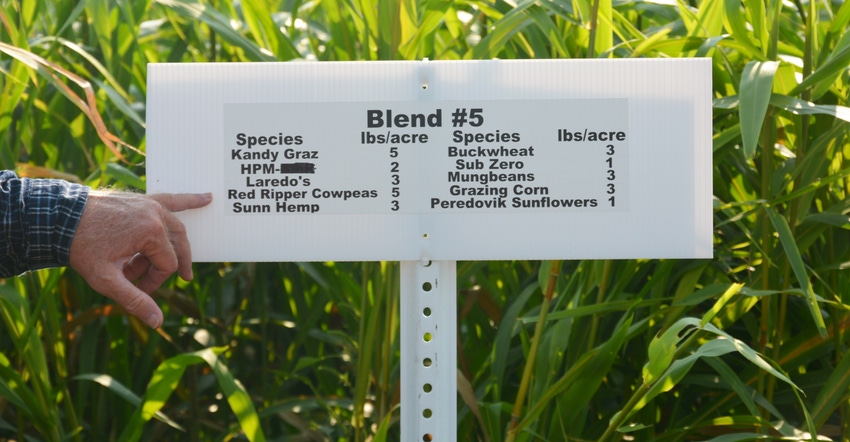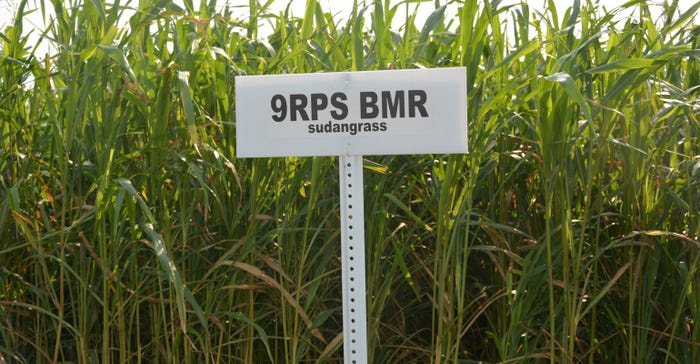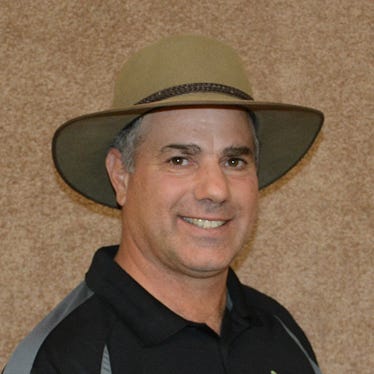
There is no magic cover crop formula. There is no guarantee that cover crops will "work" every time. The way to make cover crops deliver their best possible potential to your operation is to treat them the same way you treat your cash crops: with trial, error and a great deal of attention.
That was the message delivered by cover crop "coach" Steve Groff, a Pennsylvania farmer and cover crop expert credited with the development of the tillage radish. Groff shared his knowledge with members of the Cheney Lake Watershed conservation group in an Aug. 21 workshop and field day in Reno County.
"Mindset matters," Groff told the overflow crowd that toured cover crop demonstration plots at Kaufmann Seed in the morning and gathered for lunch and afternoon speakers at the Journey Activity Center in Yoder. "Think about everything you do to prioritize your cash crops: plant on time, use the proper seeding equipment and consistently observe the progress of the crop during the growing season."
Groff warned farmers that there will be "off" years in a 10-year cover crop management plan. Some years there will be weather, disease or insect issues that mean the crop does not do well, just as there are bad years for cash crops.
 SUCCESSFUL FORAGE: Forage sorghums and sudangrass are among the cover crops that have been shown to produce a beneficial amount of biomass in a single growing season.
SUCCESSFUL FORAGE: Forage sorghums and sudangrass are among the cover crops that have been shown to produce a beneficial amount of biomass in a single growing season.

"Just remember that this is an investment in your future," he said. "You are building long-term value into your soil."
Successful cover cropping begins with understanding soil and how it functions, Groff told the group.
"One of the important things to realize that all of our soils started out with multiple species that had living roots in the soil at all times," he said. "That diversity of growing plants is essential and something that we have only recently begun to understand."
Groff said he is a third-generation farmer and started his no-till operation in 1982. Two years later, he did his first planting into green cover crops. He was one of the first cover crop growers to use a crimper and roller to terminate his cover crop, rather than spraying with herbicide.
"After developing the tillage radish in 2001, I started the first cover crop seed company and I won the no-till product of the year three years in a row. That was my start. Then, after a problem with my partners, I came within 18 hours of losing the farm. I was able to work it out, and I got out of the seed business and into cover crop coaching," he said.
Groff said his eventual goal is to be able to eliminate the use of chemical fertilizers and pesticides, replacing them with cover crops that provide the nutrients for cash crops, keep the soil shaded to prevent weed seed from germination and attract beneficial insects that feed on cash crop pests.
"My goal is to have living roots in the soil 100% of the time," he said. "My use of fertilizer is down 39% and my use of pesticide is down 57%. Yields are the same to higher. That’s so far. But I want to warn you that this is no guarantee of results. You can’t just throw on cover crops and expect miracles. All the good comes from the right management."
Groff showed slides of a dust storm rolling across the horizon, blackening the skies behind a field of heavy residue and cover crops — a field in which no soil was moving in the face of the rolling dust storm.
"This photo was taken in Colby in the spring of 2018," he said. "This is not the Dust Bowl. This is now, here. It’s time to think differently. Now is the right time to embrace making a difference."
Groff urged farmers to always consider planting cover crops into the stubble of wheat harvest, especially in years when there is sufficient moisture to sustain their growth. He said cover crops, especially in a mix that includes legumes, often make more sense than a double-crop such as soybeans.

MEET THE COACH: Steve Groff is a third-generation Pennsylvania farmer who is credited with the development of the tillage radish. He shared some of his experiences and advice with members of the Cheney Lake Watershed conservation group at a field day in August.

"Cover crops make next year’s cash crop better by making fertilizer more efficient and preventing erosion," he said. "We actually took soil samples from "snirt" — the soil-infused snow blowing off fields — and determined that the nutrients in the eroded material are higher than in the soil left on the field. It’s the good stuff that blows away or washes away in runoff."
He said cover crops can help control resistant weeds by preventing their germination and crowding out their growth. He recommended terminating the cover crop early using a crimper and roller in dry years and letting it grow longer to help dry out soil for planting in wet years.
"I’m also starting to do a lot of work on companion crops," he said. "We’re discovering that peas and hairy vetch pair well with oilseed rape (canola)."
Looking to the future, he said the latest piece of equipment is a planter that can adjust cover crop mixes on the go to put the best plants in the right places.
"We are getting close to the day when we can have a field prescription for the right cover crops the way we have a map now for variable rate nutrient application," he said. "The planters of the future will be able to adjust on the go and give us a precision cover crop mix."
He said he also sees a future with expanded direct sales of food from farmers to consumers and he thinks that the day is rapidly approaching when the public will weigh the nutritional value of the foods they are buying and opt for more nutrient rich produce grown on higher-quality soils.
About the Author(s)
You May Also Like




